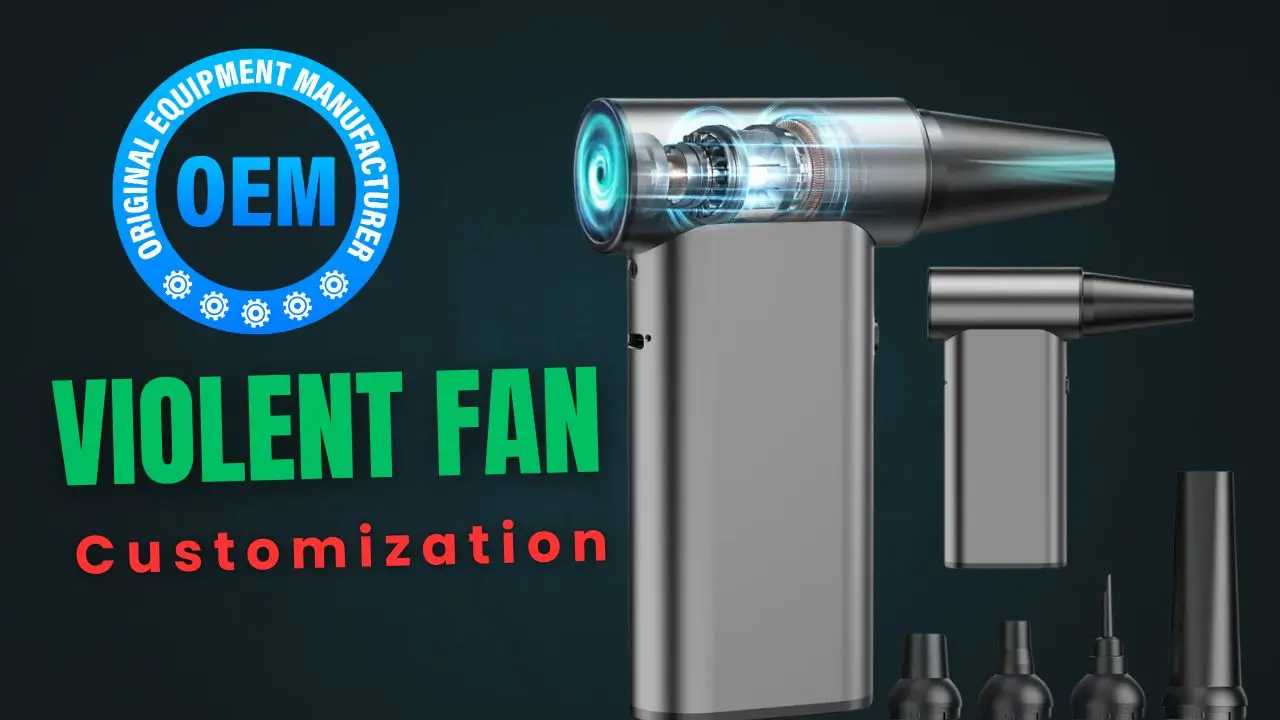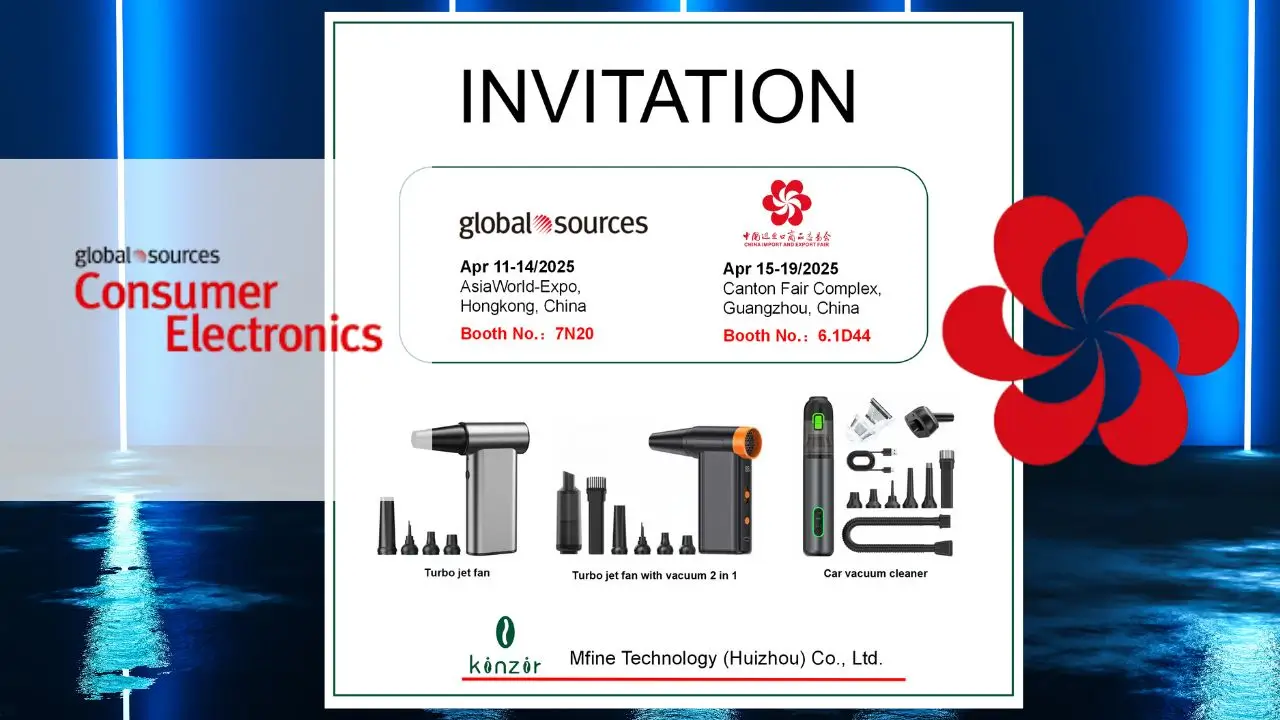If you’re weighing Electric Air Duster OEM vs ODM options, the right partnership can seriously shape your business outcomes. At Kinzir, a leading manufacturer of bulk air dusters and handheld car vacuum cleaners in China, you get both OEM and ODM solutions.
But which approach actually fits your needs? That’s where knowing the difference really matters.

OEM lets you put your brand on an existing product, while ODM allows you to develop a unique air duster based on your specific requirements. Each method brings its own flavor—customization, speed, cost—so you’ve got to pick what matters most to you.
Let’s break down the key differences, benefits, and some practical tips for choosing between Electric Air Duster OEM vs ODM. See what matches your business goals and how Kinzir can help you source the right way.
What Is OEM? (Original Equipment Manufacturer)
When you’re sourcing electric air dusters in bulk, understanding the OEM model can save you from a lot of headaches. Here’s how OEM works in this industry and what it really means for you as a buyer.
Definition and Operational Model
An Original Equipment Manufacturer (OEM) produces products or components that another company buys and sells under their own brand. For electric air dusters, an OEM supplies units tailored to your specs, but the core engineering is theirs.
The OEM doesn’t sell to end users. You buy in bulk, slap on your branding, and sell to your customers.
This setup lets you focus on marketing and sales, while technical development and manufacturing are handled by experts.
OEM in the Electric Air Duster Industry
In the electric air duster world, OEM services can cover product design tweaks and private labeling. You can specify details like motor power, nozzle types, and how the outside looks—making sure it fits your market.
Manufacturers like Kinzir offer project management, compliance testing, and packaging as part of the deal. You get bulk orders that meet your quality and regulatory standards.
OEMs are especially handy for companies scaling up or entering new markets.
Benefits of Choosing OEM
Why go OEM? Here’s what you get:
- Consistency: High-quality standards across batches.
- Brand Identity: Your logo, your colors, your packaging.
- Cost Efficiency: Bulk and standardized manufacturing means lower per-unit costs.
- Speed to Market: Skip development—get products ready to sell, fast.
- Regulatory Compliance: OEMs often handle CE, RoHS, FCC certifications for you.
For businesses looking to scale with reliable, branded electric air dusters, OEM is often a smart move.
What Is ODM? (Original Design Manufacturer)
ODM production lets you source electric air dusters based on ready-made designs. You get to market quicker, with fewer hurdles.
But how does working with an Original Design Manufacturer actually help? Let’s dig in.
Definition and Working Model
An Original Design Manufacturer (ODM) owns the product’s design and manufacturing. You pick from their designs, maybe tweak branding, color, or packaging a bit.
With Electric Air Duster ODM, you don’t pay for R\&D. The ODM handles certifications, testing, and safety compliance, so you can skip the headaches and get products faster.
Unlike OEM, you’re not handing over blueprints. You choose from a catalog—efficient, but not as flexible.
Collaborating with ODM for Electric Air Duster Production
When you partner with an ODM, your job is to specify custom touches, order quantities, and branding. The ODM covers technical and manufacturing details, including sourcing parts and keeping production steady.
Typical steps:
- Review existing models from the ODM.
- Pick a base product and outline any custom features (packaging, logo, accessories).
- Finalize requirements, volume, and delivery schedule.
Good communication is key. Kinzir, for example, has support teams to help with technical questions and logistics for big orders.
Advantages of Selecting ODM
Why choose ODM for electric air dusters? Here’s the upside:
- Speed to Market: No new designs or tooling—production is quick.
- Reduced Costs: Lower up-front spend, as design and certification are on the ODM.
- Simplicity: Streamlined process, less hassle for you.
You also get consistency in quality control, a stable supply chain, and scalable bulk ordering. For those who want reliable electric air dusters to spec—without the drama of new product development—ODM makes sense.
OEM vs ODM: Key Differences for Electric Air Dusters
OEM or ODM? This choice shapes your customization options, costs, and how much control you have over your brand. It’ll also affect your market entry speed, intellectual property, and business strategy.
Product Customization and Innovation Capability
OEM electric air dusters are highly customizable. You can tweak features, specs, branding—pretty much everything. Need unique airflow or a special look? OEM partners can make it happen with product customization services.
ODM, by contrast, offers pre-made solutions. You’ll usually just change the logo or packaging. If you’re after simplicity and aren’t picky about features, ODM is fine.
For real innovation or a unique value proposition, OEM is the better bet.
Time to Market Comparison
Speed matters. ODM gets you to market faster since products are already designed. Just handle branding and a few tweaks.
OEM takes longer—custom development, engineering, and testing stretch out the timeline.
If you’re in a rush, ODM is the shortcut. OEM lets you launch something truly unique, but you’ll wait longer.
Time to Market Timeline
| Model | Development Phase | Estimated Time |
|---|---|---|
| OEM | Design & Test | 2-9 months |
| ODM | Branding only | 2-8 weeks |
Cost-Effectiveness and Financial Implications
OEM costs more up front—development, prototyping, tooling, and quality checks add up. You might save per unit at scale, but initial budgets need to be healthy.
ODM is cheaper to start. Most costs are for bulk order minimums and branding, not R\&D.
Always check supply chain management and bulk pricing. For brands with bigger budgets, OEM can pay off long-term.
Ownership of Intellectual Property Rights
OEM gives you the strongest shot at owning intellectual property rights. You may own the design, features, and patents—great for keeping competitors at bay.
With ODM, the manufacturer owns the base product and features. You get branding rights, but not exclusive patents.
If IP is a big deal for you, OEM is the way to go. Just make sure legal terms are clear with your supplier.
Brand Positioning and Strategic Market Benefits
OEM allows you to create Private Label Electric Air Dusters tailored to your brand and market. The result? Products that stand out and can’t be easily copied.
ODM products are less unique. You can put your logo on them, but so can others, so it’s harder to lead the market.
OEM’s flexibility supports premium placement and customer loyalty. Plus, better quality assurance means your air duster keeps up with market demands.
OEM vs ODM Electric Air Dusters Comparison
| Key Aspect | OEM | ODM |
|---|---|---|
| Customization | Extensive: design, features, components | Limited: logo, packaging only |
| Innovation capability | High: unique products possible | Low: standardized models |
| Time to market | Longer: 2-9 months | Short: 2-8 weeks |
| Initial investment | High (development, tools, IP) | Low (branding, order minimums) |
| Intellectual Property Rights | Retain/own design & features, possible patents | Manufacturer retains; branding only |
| Brand positioning | Premium, differentiable | Generic, limited brand power |
| Quality assurance | Higher, custom QA process | Consistent, but based on standard QA |
| Supply chain flexibility | Tailored to needs | Pre-established, less flexible |
Pros and Cons of OEM Electric Air Dusters
OEM electric air dusters bring a streamlined development process and reliable quality. But customization and branding flexibility might be limited, depending on your OEM partner’s capabilities.
Pros of OEM Electric Air Dusters
With OEM, you get to use an existing, proven design. That means less time-to-market and less fuss with technical adjustments, since specs are already validated.
You’ll benefit from reliable supply chains, steady sourcing, and predictable production timelines. OEMs handle quality assurance and compliance, so you spend less time on admin. Bulk orders often mean better pricing, too, especially with experienced manufacturers like Kinzir.
Technical support and aftersales service are usually in place, making life easier for you and your customers. Development risks are lower because your job is mostly sales and logistics, not engineering.
Cons of OEM Electric Air Dusters
Standard OEM products limit your ability to make design tweaks or stand out. Custom colors, logos, or features might not be available—so it’s tough to tailor for niche markets.
Pricing can be rigid, and minimum order quantities are often high. If you’re a small-volume player, OEM may not fit. You’ll also be competing with others using the same base model unless you have killer marketing or extra services.
Your timeline is tied to the OEM’s production schedule, and you have less say over upgrades or design changes.
Pros and Cons of ODM Electric Air Dusters
ODM electric air dusters come with unique advantages and a few trade-offs. Here’s what you should know about flexibility, cost, and customization with ODM.
Pros of ODM Electric Air Dusters
ODM lets you access pre-designed products that are ready for your branding. That saves you a ton of development time.
You can choose from a catalog, which means faster launches. Cost savings are common—no need for big R\&D spend, and pricing is often competitive due to economies of scale.
The process is pretty simple. You can usually get private labeling, color options, or custom packaging without major delays. Certifications and compliance? The manufacturer handles it.
Cons of ODM Electric Air Dusters
The main downside is limited customization. You’re picking from standard models, so changes are mostly cosmetic.
It’s also harder to stand out—other brands might sell the same model with different packaging. Price competition can get fierce in crowded markets.
You don’t own the intellectual property, so you can’t control core innovations or features. If you want exclusivity or advanced tweaks, OEM is probably a better fit.
OEM and ODM Case Studies: Real-World Examples

Electric air dusters have been made using all sorts of manufacturing models. Looking at real OEM and ODM projects gives you a clearer idea of what works for electronics cleaning businesses.
Successful OEM and ODM Projects in the Electric Air Duster Industry
In one OEM case, a big electronics retailer hired a factory to create a custom-branded air duster. The manufacturer handled branding, packaging, and a special nozzle design, plus mass production and quality checks.
On the ODM side, a European distributor worked with a manufacturer to develop a new duster with digital display and variable speeds. The factory took care of design, prototyping, and testing. The finished product was sold under the distributor’s label, hitting unique market needs with less risk.
Key project differences:
- OEM: Custom branding and tweaks.
- ODM: End-to-end design innovation and new features.
Kinzir’s Experience and Track Record
Kinzir has built a solid rep as a top electric air duster factory, offering both OEM and ODM solutions. You get rapid prototyping, flexible bulk quantities, and tight timelines.
Through OEM, Kinzir helps brands scale with private label dusters, custom packaging, and market-specific certifications. With ODM, they’ve rolled out dusters featuring HEPA filters and adjustable airflow for electronics cleaning.
Clients like detailed documentation, clear communication, and on-site inspections. This makes sure you get high-quality, market-ready air dusters every time.
How to Choose Between OEM and ODM for Your Electric Air Duster
Deciding between OEM and ODM shapes your product’s features, customization, and supply chain. Smart B2B procurement means really thinking through your production, branding, and growth plans.
Essential Checklist and Factors for Decision-Making
OEM (Original Equipment Manufacturer) is best if you have a finished design and strict branding needs. You control the IP and can specify materials, functions, and features. This works for businesses with strong product engineering and compliance know-how.
ODM (Original Design Manufacturer) is for buyers who want ready-made solutions to rebrand. ODM partners do the design, development, and production. It’s faster, less unique, and lowers your risk and technical burden.
Key factors to consider:
| Decision Point | OEM | ODM |
|---|---|---|
| Brand Control | Full | Limited |
| Customization | High | Low to Moderate |
| Initial Investment | Higher | Lower |
| Speed to Market | Slower | Faster |
| Procurement Complexity | High (specs, IP) | Low |
Think about your supply chain, brand vision, and technical chops. Matching these with your procurement strategy sets you up for a smoother electric air duster launch.
Why Choose Kinzir for Your OEM or ODM Electric Air Duster Needs
Picking an electric air duster provider isn’t just about price—it’s about finding a partner who gets quality and detail. Kinzir delivers tailored OEM and ODM solutions that help your brand stand out.
Kinzir’s Manufacturing Capabilities and Expertise
Kinzir runs modern facilities with automated lines, so every unit meets the mark. Our engineers work with you to refine designs for both OEM and ODM projects.
Capabilities include:
- Injection molding for custom housings
- PCB assembly and precise electronics integration
- Layered quality inspection at every stage
We handle both small and large orders, and we’re experienced with CE, RoHS, and FCC certifications for global markets.
Unique Selling Points of Kinzir
With Kinzir, you get strict quality control, clear communication, and dedicated project management. Your project is tracked from idea to shipment by a skilled team.
Our service highlights:
- Full private label and customization support
- Fast prototyping for quicker launches
- Transparent lead times and tracked logistics
You’ll also get thorough documentation, after-sales help, and direct technical support for every order. With Kinzir, you can scale custom requirements, knowing your manufacturing partner is reliable and meets industry standards.
Conclusion: Making the Right OEM vs ODM Decision
Choosing between OEM and ODM for electric air dusters really comes down to your goals, resources, and timeline. Each has its perks, depending on what matters most to you.
OEM is for those who want a custom design and more control over specs and branding. You’ll need to invest more, but you get a unique product.
ODM is a better fit if you want something off-the-shelf, with quick lead times and lower costs. You can brand pre-made products and get to market fast.
| Option | Customization | Time to Market | Cost | Control |
|---|---|---|---|---|
| OEM | High | Longer | Higher | More |
| ODM | Moderate | Shorter | Lower | Less |
Questions to ask yourself:
- How much customization do you need?
- How quickly do you want to launch?
- Are there specific features or quality levels you require?
- What’s your budget?
Talk through your goals and expected volume with your manufacturing partner. Kinzir, as a leading OEM and ODM manufacturer, is ready to help you pick the best path.
Frequently Asked Questions
Choosing between OEM and ODM for electric air dusters is about design control, customization, costs, IP rights, and other operational priorities. Knowing these helps you make a smarter decision when launching or expanding your product line.
What are the main differences between OEM and ODM production for electric air dusters?
OEM means you provide the design and specs, and the manufacturer builds it. ODM offers pre-designed air dusters that you can brand as your own.
OEM gives you more control over features and tech. ODM is faster to market but less flexible in design.
How does the customization process vary between OEM and ODM for electronic cleaning tools?
OEM lets you pick materials, set performance standards, and add unique features. You can change both the look and the guts.
ODM customization is usually just branding and minor cosmetic tweaks. The internals stay the same.
Can you explain the impact of choosing ODM over OEM on product quality and design for air dusters?
ODM products use proven designs and are tested for consistency. Quality is reliable if the supplier is solid, but you can’t change much.
OEM lets you get bespoke features and higher differentiation. Quality can match your exact specs, as long as you manage development and oversight well.
What should be considered when deciding between OEM and ODM for manufacturing commercial-grade electric air dusters?
Think about budget, lead time, technical specs, and brand identity. For unique or advanced features, OEM is usually better.
If you need fast rollout and lower costs, ODM makes more sense. Always check supplier capabilities and after-sales support.
Are there specific cost implications when selecting OEM or ODM for a new line of electric air dusters?
OEM projects need more up-front investment for research, molds, and development. Unit costs drop with bigger orders, but small runs can be pricey.
ODM has lower initial costs. Since you’re not paying for development, you mostly pay for production and branding.
How does intellectual property protection differ between OEM and ODM partnerships in the electronic cleaning devices sector?
With OEM, IP you develop or supply is usually yours. You can protect it with licensing or confidentiality agreements.
In ODM, the factory owns most design IP. Your rights are mostly limited to your logo and any customizations outside the core design.




